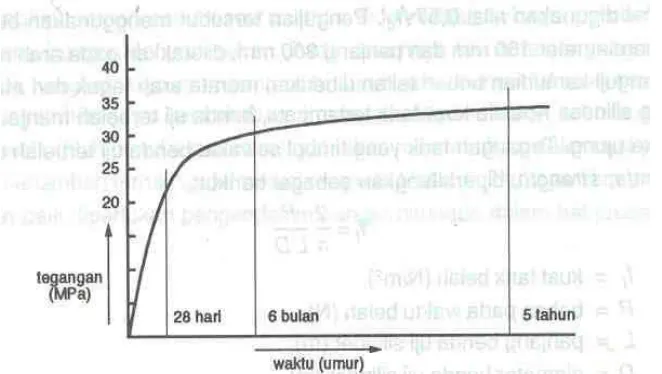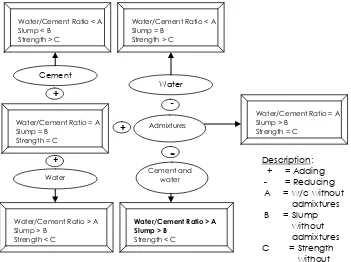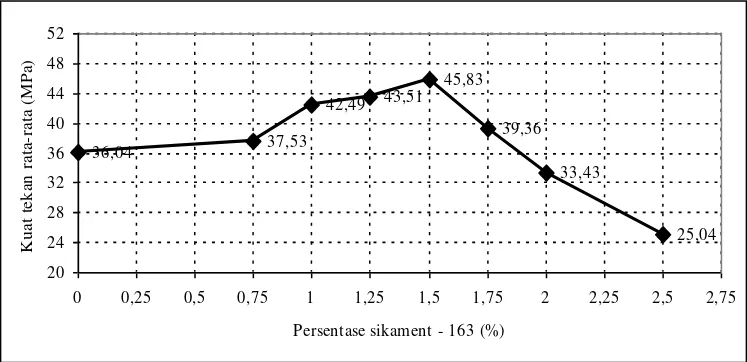ANALYSIS OF THE OPTIMUM PERCENTAGE OF ADMIXTURE OF SIKAMENT-163, WHICH CAN BE ADDED INTO CONCRETE MIXTURE TO ACHIEVE THE MAXIMUM
OF CONCRETE COMPRESSION STRENGTH
Gidion Turu’allo*
Abstrak
Penelitian ini bertujuan untuk mendapatkan prosentasi optimum dari bahan tambahan Sikament-163 yang dapat ditambahkan ke dalam campuran beton untuk memperoleh kuat tekan beton maksimum. Prosentasi dari Sikament-163 yang ditambahkan ke dalam campuran beton bervariasi dari 0 % (beton normal), 0,75 %, 1 %, 1,25 %, 1,5 %, 1,75 %, 2 %, dan 2,5 % dari berat semen. Penelitian ini dilaksanakan dengan menggunakan 9 benda uji untuk setiap prosentasi penambahan Sikament-163 dan pengetesan dilakukan pada waktu umur beton mencapai 28 hari. Hasil percobaan menunjukkan bahwa prosentasi optimum dari Sikament-163 yang ditambahkan ke dalam campuran beton untuk mendapatkan kuat tekan beton maksimum adalah 1,5 %. Hal ini disebabkan penambahan Sikament-163 lebih dari 1,5 % ke dalam campuran beton akan menyebabkan jumlah air yang digunakan kurang dari jumlah air yang diperlukan untuk berlangsungnya proses hidrasi yang sempurna. Sebagai hasilnya, beton yang dihasilkan mempunyai kuat tekan yang lebih rendah.
Kata kunci: bahan tambahan, beton, dan kuat tekan beton
Abstract
This research aims to find out the optimum percentage of admixture of Sikament-163, which can be added into concrete mixture to achieve the maximum of concrete compression strength. The percentages of Sikament-163, which are added in concrete mixture, are 0 % (normal concrete), 0.75 %, 1 %, 1.25 %, 1.5 %, 1.75 %, 2 % and 2.5 % by cement weight. The research is conducted using nine test specimens for each percentage of Sikament-163 with the same slump. The tests
were conducted, when the concrete’s age reached 28 days. The results of test show that the optimum percentage of Sikament-163, which is added into concrete mixture to achieve the maximum of concrete compression strength is 1.5 %. This is caused the adding admixture Sikament-163 into concrete mixture more than 1.5 % by cement weight can reduce more of used water for the same slump; therefore, the used water less than that is needed to perform completed hydration process. As the result, the compression strength of concrete was produced, become lower.
Keyword: Admixture, Concrete, and Concrete Compression Strength, pengungsian
* Staf Pengajar Jurusan Teknik Sipil Fakultas Teknik Universitas Tadulako, Palu
1. Introduction
Concrete is made from a properly proportioned mixture of hydraulic cement, water, fine and coarse aggregates, and often, chemical or mineral admixtures. The most common hydraulic cement used in construction today is portland cement. The successful
Admixtures are materials other than cement, aggregate and water that are added into concrete either before or during its mixing to alter its properties, such as workability, curing temperature range, set time or color. Some admixtures have been in use for a very long time, such as calcium chloride to provide a cold-weather setting concrete. Others are more recent and represent an area of expanding possibilities for increased performance. Not all admixtures are economical to employ on a particular project. Also, some characteristics of concrete, such as low absorption, can be achieved simply by consistently adhering to high quality concreting practices.
Admixtures vary widely in chemical composition, and many perform more than one function. Two basic types of admixtures are available: chemical and mineral. All admixtures to be used in concrete construction should meet specifications; tests should be made to evaluate how the admixture will affect the properties of the concrete to be made with the specified job materials, under the anticipated ambient conditions, and by the anticipated construction procedures.
Water-reducing admixtures are groups of products that are added to concrete to achieve certain workability (slump) at a lower w/c than that of normal concrete. Water-reducing admixtures are used to improve the quality of concrete and to obtain specified strength at lower cement content. They also improve the properties of concrete containing marginal- or low-quality aggregates and help in placing concrete under difficult conditions (ACI Commentary 212 1963). Although using admixtures in concrete improves concrete's properties, misusing any kind of admixtures will negatively affect these properties. It is therefore important to follow the manufacturer's recommendations whenever admixtures are used. Sikament admixture; particularly Sikament-163 begins to be used people in construction in Palu;
therefore, study about using of the admixtures in concrete mixture need to
be conducted to evaluate it’s effects to the concrete’s characteristic such as
concrete compression strength, workability of concrete, durability of concrete, etc.
2. Literature Study
The chemistry of concrete admixtures is a complex topic requiring in-depth knowledge and experience. A general understanding of the options available for concrete admixtures is necessary for acquiring the right product for the job, based on climatic conditions and job requirements. Based on their functions, admixtures can be classified into the five major categories; i.e. retarding admixtures, accelerating admixtures, super plasticizers, water reducing admixtures, and air-entraining admixtures.
2.1Types of Admixture 2.1.1 Retarding admixtures
Retarding admixtures slow down the hydration of cement, lengthening set time. Retarders are beneficially used in hot weather conditions in order to overcome accelerating effects of higher temperatures and large masses of concrete on concrete setting time. Because most retarders also act as water reducers, they are frequently called water-reducing retarders. As per chemical admixture classification by ASTM-ASTM C 494, type B is simply a retarding admixture, while type D is both retarding and water reducing, resulting in concrete with greater compressive strength because of the lower water-cement ratio.
Retarding admixtures consists of both organic and inorganic agents. Organic retardants include unrefined calcium, sodium, NH4, salts of
(Gidion Turu’allo)
properties, lignosulfate acids and hydroxylated carboxylic acids slow the initial setting time by at least an hour and no more than three hours when used at 65 to 100 degrees Fahrenheit.
2.1.2 Accelerating admixtures
Accelerators shorten the setting time of concrete, allowing a cold-weather pour, early removal of forms, early surface finishing, and in some cases, early load application. Proper care must be taken while choosing the type and proportion of accelerators, as under most conditions, commonly used accelerators cause an increase in the drying shrinkage of concrete.
Calcium chloride is a common accelerator, used to accelerate the time of set and the rate of strength gain. It should meet the requirements of ASTM D 98. Excessive amounts of calcium chloride in concrete mix may result in rapid stiffening, increase in drying shrinkage and corrosion of reinforcement. In colder climates, calcium chloride should not be used as an anti-freeze. Large amount of calcium chloride is required to lower the freezing point of the concrete, which may attack the concrete itself.
2.13 Super plasticizers
Super plasticizers, also known as plasticizers, include water-reducing admixtures. Compared to what is commonly referred to as a "water reducer" or "mid-range water reducer", super plasticizers are "high-range water reducers". High range water reducers are admixtures that allow large water reduction or greater flow ability (as defined by the manufacturers, concrete suppliers and industry standards) without substantially slowing set time or increasing air entrainment.
Each type of super plasticizer has defined ranges for the required quantities of concrete mix ingredients, along with the corresponding effects. They can maintain a specific consistency and workability at a greatly reduced amount of water. Dosages
needed vary by the particular concrete mix and type of super plasticizer used. They can also produce a high strength concrete. As with most types of admixtures, super plasticizers can affect other concrete properties as well. The specific effects, however, should be found from the manufacturer or concrete supplier.
2.14 Water reducing admixtures
Water reducing admixtures require less water to make a concrete of equal slump, or increase the slump of concrete at the same water content. They can have the side effect of changing initial set time. Water reducers are mostly used for hot weather concrete placing and to aid pumping. A water-reducer plasticizer, however, is a hygroscopic powder, which can entrain air into the concrete mix via its effect on water's surface tension, thereby also, obtaining some of the benefits of air-entrainment.
2.15 Air-entraining admixtures
Air-entraining agents entrain small air bubbles in the concrete. The major benefit of this is enhanced durability in freeze-thaw cycles, especially relevant in cold climates. While some strength loss typically accompanies increased air in concrete, it generally can be overcome by reducing the water-cement ratio via competent professional because some of them can interact in undesirable ways.
Bonding admixtures, including addition of compounds and materials such as polyvinyl chlorides and acetates, acrylics and butadiene-styrene co-polymers, can be used to assist in bonding new / fresh concrete with old / set concrete.
2.2 Concrete Compression Strength
of its components. Because cement is the most active component of concrete and usually has the greatest unit cost, its selection and proper use are important in obtaining most economically the balance of properties desired for any particular concrete mixture.
The concrete compression strength will increase by increase of its age as the Figure 1 shown below. The increasing of concrete compression strength is also affected by some factors such as water cement ratio, curing temperature, etc. The higher of its water cement ratio the lower of its increasing strength.
Type I / II Portland cements, which can provide adequate levels of strength and durability, are the most popular cements used by concrete producers. However, some applications require the use of other cements to provide higher levels of properties. The need for high-early strength cements in pavement repairs and the use of blended cements with aggregates susceptible to alkali-aggregate reactions are examples of such applications.
It is essential that highway engineers select the type of cement that will obtain the best performance from the concrete. This choice involves
the correct knowledge of the relationship between cement and performance and, in particular, between type of cement and durability of concrete.
The manufacture and
composition of Portland cements, hydration processes, and chemical and physical properties have been repeatedly studied and researched, with innumerable reports and papers written on all aspects of these properties.
2.2.1 The Effect of Water / Cement Ratio to Concrete Compression Strength.
The strength of hardened cement depends on the number of water used for the hydration process takes places. The hydration process basically, needs water of about 25 % of cement weight
(Tjokrodimulyo, 1996). Abrams’ Law
states that assuming full compaction, and at a given age and normal temperature, strength of concrete can be taken to be inversely proportional to the water/cement ratio as the formula below,
wcr
B
A
c
f
'
………..(1)(Gidion Turu’allo)
where, f’c and wcr are the concrete
compression strength and
water/cement ratio respectively; while A and B are constants. The higher the ratio, the greater the water consequently, the concrete assumes less compressive strength. Also, more days of wet curing are required to obtain the hardness necessary to hard off moisture migration. For example, the ideal ratio is 0.40 to 0.45, which would require seven days of wet cure. The number of water used in concrete mix is strongly related to the slump value of concrete fresh. The more water used in the concrete mix, the higher the slump.
The relationship between cement and water content is crucial importance to the concrete durability. Capillary porosity formed from residual spaces occupied by mix water increases with higher w/c ratio within ordinary Portland cement. In this manner, increased water content within the original mix indicates
a lower strength and a potential decrease in durability.
2.2.1 The effect of Admixtures to Concrete Compression Strength.
The concept of using admixtures in concrete mixture can be seen in the Figure 2 below. As can be seen from the figure; the adding of admixture into concrete mixture at the same slump with normal concrete by reducing used water can increase the concrete compression strength. The concrete compression strength also can be increase by adding cement as the picture shows; however adding cement will reduce workability of concrete due to reduce of concrete slump. Even using cement exceed from the needed amount will generate a new problem in concrete itself, i.e. it will generate shrinkage and creep in concrete at earlier time; therefore it will reduce concrete compression strength (Haidar, 2002).
Figure 2. Concept of Using Admixtures
Water/Cement Ratio < A Slump < B
Strength > C
Cement
Water/Cement Ratio = A Slump = B
Strength = C
Water
Water/Cement Ratio > A Slump > B
Strength < C
Admixtures Water/Cement Ratio < A Slump = B
Strength > C
Water/Cement Ratio = A Slump > B
Strength = C
Water
+
+
-
-
Water/Cement Ratio > A Slump > B
Strength < C Cement and
water
+
Description: + = Adding - = Reducing A = w/c without
admixtures B = Slump
without admixtures C = Strength
36,04 37,53
42,49 43,51 45,83
39,36
33,43
25,04
20 24 28 32 36 40 44 48 52
0 0,25 0,5 0,75 1 1,25 1,5 1,75 2 2,25 2,5 2,75 Persentase sikament - 163 (%)
Ku
a
t
te
k
a
n
r
a
ta
-r
a
ta
(
M
P
a
)
3. Experimental Program 3.1 Materials Testing
The materials used to produce concrete in this research should be fulfilling the required specification before used; otherwise, the materials cannot be used. Those materials are both fine and coarse aggregates, cement and water. The coarse aggregate in from stone crushed was taken from Taipa river, while fine aggregate was taken from Palu river. The used cement selected from type I brand Tonasa.
The aggregates’ testing, which
are done; are sieve analysis, aggregates water content, aggregates soil content, specific bulk gravity, organic content and wearing out test by Los Angeles machine.
3.2 Mix Design
The composition of materials,
which used in the concrete mix, is calculated based on the Indonesia code for Normal Concrete Mix Design (SK SNI T-15-1990-03). The average of concrete compression strength is calculated by following equation.
f’cr = f’c + 1.64 S ………..(2)
or f’cr = f’c + M ………(3)
where, f’cr = the average of concrete
compression strength
f’c = required concrete compression strength.
S = Standard deviation value (taken 7 MPa if the previous experienced data not available).
M = Additional value, Margin; It is taken 12 MPa if the previous data not available.
3.3. Sample Test
The test specimens made of concrete cube of 150 mm x 150 mm x 150 mm size. Tests of the sample cubes were done when those ages were 28 days. The number of samples used in the test can be seen in the Table 1 below.
4. The Experimental Results and Discussion.
4.1 The Experimental Results.
The concrete compression test
results at each concrete’s age is
presented in the Figure 3 below.
(Gidion Turu’allo)
Table 1.The number of test specimens
Concrete type Percentage of Sikament-163 (%) Total
0 0.75 1 1.25 1.5 1.75 2 2.5
Number of
test specimens
9 9 9 9 9 9 9 9 72Table 2. Relation between the percentage of Sikament-163 with water cement ratio.
No
Percentage of Sikament-163 by cement
weight
Used water (kg)
Cement weight (kg)
Water cement ratio
1 0 6.2357 10.9928 0.5673
2 0.75 5.9604 10.9928 0.5422
3 1.0 5.8209 10.9928 0.5295
4 1.25 5.6500 10.9928 0.5140
5 1.5 5.4996 10.9928 0.5003
6 1.75 5.2895 10.9928 0.4812
7 2.0 5.0231 10.9928 0.4569
8 2.5 4.4196 10.9928 0.4020
The test results above show that the maximum concrete compression strength is achieved when the percentage of Sikament-163 which was added into concrete mixture is 1.5 % by cement weight. The graph also shows that add the Sikament-163 more than 1.5 % will reduce the compression strength from the obtained maximum value; even add it more than 2 % will produce concrete with compression strength lower than normal concrete. Another result of this research such as the relation between the percentages of Sikament-163 with water cement ratio is shown in Table 2 below. The table shows that the higher percentage of Sikament-163 produces the lower water cement ratio of concrete mixture.
4.2 Discussion
Figure 3 above shows that using of Sikament-163 as much 1.5 % by cement
expected to have higher strength. However, it gives reverse results; it is caused the used water by adding Sikament-163 more than 2 % into concrete mixture less than amount water that is needed to perform a completed hydration process even though it results concrete with lower water cement ratio or increased workability.
In conclusion, the optimum percentage of Sikament-163, which can be added into concrete mixture; is 1.5 % with reducing water till 11.8 % from that is used for normal concrete. The produced concrete results the compression strength of 27.16 % higher than normal
concrete’s strength. Moreover, using of
the Sikament-163 which produced by Sika Company can also increase concrete workability.
4.3 Suggestion for the future work It is needed to advanced study the effects of Sikament-163 admixture to the durability concrete especially to corrosion of reinforced concrete embedded in concrete to know whether the Sikament-163 effect the passive layer of concrete or not.
5 References
Anonim , 2003, “Bahan Presentasi Sika”, PT Sika Indonseia
Callister Jr., W. D. 2003, Materials Science
and Engineering —An
Introduction, 6th ed. New York: Wiley,
Departemen Pekerjaan Umum, Tata
Cara Pembuatan Rencana
Campuran Beton Normal (SK SNI T-15-1990-03), Yayasan LPMB, Bandung.
Gani, M.S.J., 1997, Cement and Concrete, Chapman and Hall
James M. dan Harper, P.E., 1999, Effects
of Aggregates on Concrete
Properties, Journal of Materials Engineering, ASCE
Khalil Haidar, 2002, Influence of Porosity on Fracture Characteristics in Mortar Structures, 15th ASCE
Engineering Mechanics Conference.
Mehta P.K. dan Paulo Monteiro J.M., 2001, Concrete: Microstructure, Properties and Matrials.
Murdock, L.J. dan Brook, K.M. 1999,
Bahan dan Praktek Beton,
Erlangga. Jakarta.
Neville, A.M. dan Brooks, J.J., 1998,
Concrete Technology, Longman Singapore Publisher.
Ran Huang and Chung Chia Yang, 2000,
Effects of Aggregate Volume Fraction on the Elastic Moduli and Void ratio of Cement Based Materials,, Journal of Marine science and Technology, Vol.8, No, 1.
Raymond W.N. Chan dan Erich P.W Chan. 1999, Using Admixtures for Concrete Construction, Journal of Materials Engineering, ASCE.
Supartono, F.X, 1999, Rancangan Campuran Beton Mutu Tinggi Berdasarkan Rumusan Abrams-FXS, Indoconstruction.


